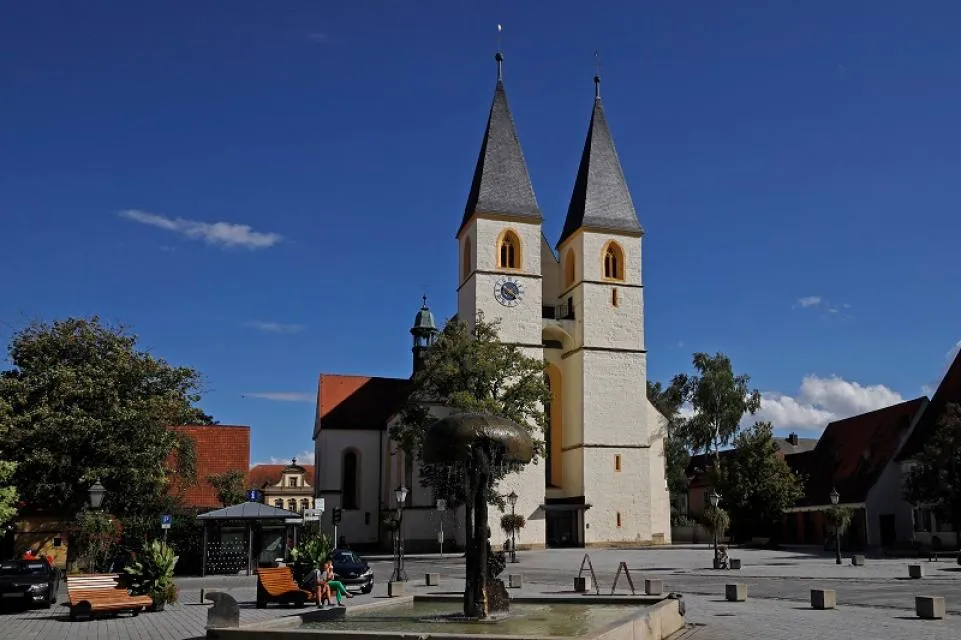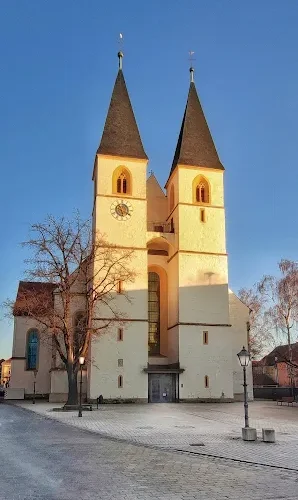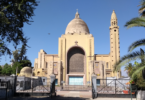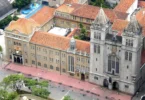Introduction

The collegiate church of St. Vitus and St. Deocar, located in Herrieden, a town in the district of Middle Franconia (Mittelfranken), Bavaria, was elevated to the status of a Basilica Minor by Pope Benedict XVI on July 14, 2010. This honor made it one of only three Basilicas Minores in the Diocese of Eichstätt, alongside the Franciscan basilica in Ingolstadt and the pilgrimage basilica in Wemding. It holds the distinction of being the only Basilica Minor in the region of Middle Franconia.
The church underwent extensive restoration work between 1999 and 2008, addressing both structural and artistic aspects of the building. The restoration was aimed at preserving and enhancing the church’s historical and architectural integrity. Some areas, however, were not fully completed until 2009, including the intricate iron grille and the figures of the apostles depicted on the choir stalls. Additionally, a major restoration of the Mount of Olives, a significant part of the church’s iconography, was carried out in 2010. This comprehensive restoration effort contributed to the preservation of the church’s cultural and religious heritage, ensuring that the basilica remains a place of spiritual significance and a testament to the region’s rich history.

The original church of St. Vitus and St. Deocar in Herrieden was consecrated in 1071 by Bishop Gundekar II as the collegiate church of Herrieden. Over the centuries, the church underwent numerous structural changes, reflecting the evolving architectural styles and the town’s growth. The church’s distinctive twin towers, which stand closely together, were likely completed at the turn of the 13th to 14th century. These towers are considered an example of early Gothic style, which was prevalent during this period. The first choir of the church was constructed in 1340, though the current choir, a magnificent example of late Gothic design, was built between 1447 and 1461.
In 1490, a devastating fire ravaged the town of Herrieden, including the church, necessitating extensive rebuilding. Between 1502 and 1533, the church was enlarged and remodeled in the late Gothic style. During this period, two large chapels were added: St. Peter’s Chapel on the north side and St. Nicholas Chapel, both of which retain their late Gothic characteristics. In 1677 and 1683, a painted wooden ceiling was installed in the nave, adding to the church’s intricate artistic details. This ceiling, which is still present today, showcases the Baroque influence that began to shape the church’s interior.The Baroque redesign of the church began in earnest with the renovation of St. Peter’s Chapel between 1740 and 1748. Over the next few years, the nave was vaulted, and the interior was adorned with elaborate stucco work, further enhancing the church’s Baroque character. Much of the Baroque interior design is attributed to the renowned architect Gabriel de Gabrieli, whose work included the ornate details that still define the church’s visual appeal.
In 1851, in an effort to provide the congregation with a clearer view of the choir during services, the cross altar was removed, and the choir grille from 1735 was relocated beneath the gallery. This adjustment was part of the ongoing process of adapting the church’s layout to better serve the needs of the faithful. Over the years, several restoration campaigns were undertaken to preserve the church’s architectural and artistic heritage. These included restoration work in 1878-79, followed by further interior restoration in 1947-48. The exterior of the church also underwent restoration in 1968. The most extensive restoration project took place from 1999 to 2008, during which the church underwent a complete renovation to preserve its historical and artistic significance for future generations. Each of these efforts has contributed to the church’s current state, a harmonious blend of medieval, late Gothic, and Baroque elements that reflect its long history and its importance as a religious and cultural landmark in the region.

The Architectural evolution of St. Vitus and St. Deocar Church reflects a history of significant construction, modifications, and restoration efforts, shaped by both religious and historical events. Key building projects began in the late 13th century, and over the centuries, the church has undergone multiple renovations to preserve and enhance its structural and artistic integrity.
The Rich Baroque Interior and Artistic Elements of St. Vitus and St. Deocar Church
The interior of St. Vitus and St. Deocar Church is a striking contrast to its modest exterior, offering a richly decorated Baroque aesthetic. The space is filled with intricate artistic details that elevate the worship experience and provide a visual narrative of the church’s religious heritage.
The Choir : A Fusion of Late Gothic and Baroque Styles
The choir of the church presents a seamless fusion of late Gothic architecture and Baroque ornamentation. The diamond-shaped vault of the choir’s ceiling is a distinct late Gothic feature, symbolizing a connection to the medieval architectural traditions of the church. Surrounding the vault, delicate stucco work enhances the space, adding Baroque flair and a sense of dynamism to the otherwise Gothic forms. The vault’s design, with its pointed arches and intricate details, directs the viewer’s attention upwards, evoking a sense of spiritual elevation. Dominating the choir are four large canvas paintings from the 18th century, which capture key moments from Christian theology. These powerful works not only enhance the beauty of the space but also convey important religious messages. The paintings include:
The Birth of Christ: This depiction of the Nativity celebrates the beginning of the divine story of Jesus, a focal point of Christian belief.
The Last Supper: A moving representation of Christ’s final meal with his disciples, underscoring the institution of the Eucharist.
The Resurrection: This powerful image symbolizes Christ’s victory over death and is a cornerstone of Christian faith.
The Sending of the Holy Spirit: Depicting Pentecost, this scene illustrates the moment when the Holy Spirit descended upon the apostles, empowering them to spread the Gospel.
These paintings, each rich in theological symbolism, contribute to the spiritual atmosphere of the choir, inviting worshippers into deeper reflection and reverence.
The Nave: Frescoes and Ceiling Paintings by Edmund Wiedemann

Moving into the nave, the artistic focus shifts to the frescoes painted by Edmund Wiedemann. These works of art adorn the walls of the nave, showcasing the patron saints of the church as well as the saints of the Diocese of Eichstätt, further connecting the church to its local religious community. Each fresco is carefully executed, portraying the saints in vivid color and intricate detail, adding to the overall sense of holiness within the space. The ceiling paintings in the nave are among the most dramatic artistic elements of the church. These large-scale works illustrate the lives and martyrdoms of key saints, as well as the divine interventions that have shaped Christian history. The ceiling frescoes include:
The Martyrdom of St. Vitus: This striking scene depicts St. Vitus suffering martyrdom in an oil cauldron, a powerful symbol of faith under persecution.
The Healing of Diocletian’s Son: A depiction of St. Vitus healing one of Emperor Diocletian’s sons, showcasing the saint’s miraculous power and intercession.
The Coronation of Mary: This scene illustrates the exaltation of the Virgin Mary as Queen of Heaven, a central figure in Catholic devotion.
The Visit of Emperor Charlemagne to St. Deocar: A historical scene showing the reverence Emperor Charlemagne had for St. Deocar, underscoring the saint’s importance to the church.
The Healing of the Sick through the Intercession of St. Deocar: A depiction of St. Deocar’s power to heal through his prayers, highlighting his role as a protector and healer.
These frescoes serve not only as artistic masterpieces but also as visual narratives of faith, embodying key moments from the lives of saints and important figures in the Christian tradition.
Gallery Parapet Paintings
In addition to the frescoes and ceiling paintings, additional paintings can be found on the gallery parapet, further enriching the visual environment of the church. These works extend the artistic program, depicting further religious figures and enhancing the overall sense of sacredness within the church. Together, the artistic elements in the choir and nave, from the grand 18th-century paintings to the intricate frescoes and ceiling scenes, create a deeply immersive spiritual experience. The combination of Baroque and late Gothic styles enriches the architectural and artistic narrative, inviting worshippers into a reflective and visually captivating space.
Organ

The organ goes back to an instrument that was built in 1780 by the court and country organ maker Georg Martin Gessinger from Rothenburg ob der Tauber (1717–1791). Over time, the organ was rebuilt or rebuilt several times. The current organ was built in 1974 by the Steinmeyer company and expanded by two registers in 2008. The slider chest instrument now has 35 registers on three manuals and a pedal .
The Collegiate Church Bells of St. Vitus and St. Deocar
The St. Vitus and St. Deocar Collegiate Church is home to a distinguished five-part chime that enhances the spiritual atmosphere of the church. The chime consists of two sets of bells, each with its own history and significance.
The North Tower Bells (1728)
The two lowest-pitched bells of the chime, which produce the deep and resonant tones, were cast in 1728. These bells, which hang in the north tower of the church, are among the oldest bells in the church and have a rich history. Their sound serves as a powerful call to worship, marking the rhythm of the liturgical day and adding to the church’s sonic heritage. Over the centuries, these bells have witnessed the passing of time and continue to serve the faithful with their deep, reverberating tones.
The South Tower Bells (1980)
The three smaller bells of the chime were cast in 1980 and are located in the south tower. These newer bells complete the five-part chime, providing higher-pitched tones that blend harmoniously with the deeper bells in the north tower. Though they are much younger than their counterparts, these bells maintain the tradition of bell ringing at the church, adding a distinct and melodic layer to the overall chime. Together, the five bells of the St. Vitus and St. Deocar Collegiate Church create a beautiful and evocative soundscape, with the older bells providing a solemn resonance and the newer bells adding a lighter, more melodic tone. This chime plays an important role in the church’s auditory identity, marking time and drawing the community together for worship and reflection.
Equipment
- The baroque high altar was designed by court building director Jakob Engel in 1695. The altarpiece was created by Johann Caspar Sing .
- The Jesuit altar dates from 1773/76 and shows Ignatius of Loyola , Francis Xavier and the Japanese martyrs.
- The second side altar (Plague/Sebastian Altar) is on the opposite side.
- Other side altars in the central nave are the Epiphany Altar from 1770, the Willibald Altar from 1726 and the Altar of St. Deocar from the second half of the 18th century.
- The baroque pulpit was made by Johannes Bernhard Koch in 1720/30 and features gilded ornaments.
- The choir stalls date from the second half of the 15th century and are decorated with statues of apostles and prophets.
- The Basilius Chapel, built at the beginning of the 16th century and remodeled in the neo-Gothic style in 1882, contains the tomb of St. Deocars, which itself dates from 1482.
Feast Day
Feast day: Saint Vitus’ feast day is on 15 June
Saint Deochar’s feast day is on 7 June.
The Feast day for the Basilica of Sts. Vitus and Deocar in Herrieden, Germany, would typically be celebrated on the feast days of the individual saints it is dedicated to.
Saint Vitus’ feast day is on 15 June (or 28 June on the Gregorian calendar in places that use the Julian calendar).
Saint Deochar’s feast day is on 7 June.
In Herrieden, where the basilica is located, it is likely that these dates are observed, either separately or in conjunction, depending on local traditions.
Church Mass Timing
Monday : 8:00 am.
Tuesday : 6:30 pm.
Thursday : 6:30 pm.
Friday : 8:00 am.
Saturday : 6:30 pm.
Sunday : 10:00 am., 11:00 am.
Church Opening Time:
Monday : 8:00 am.
Tuesday : 6:30 pm.
Thursday : 6:30 pm.
Friday : 8:00 am.
Saturday : 6:30 pm.
Sunday : 10:00 am., 11:00 am.
Contact Info
Address :
Marktpl. 1, 91567 Herrieden, Germany.
Phone : + 0982592940
Accommodations
Connectivities
Airway
The Nearest Airport to The Church of Basilica of Sts. Vitus and Deocar, Herrieden, Germany, is, Katterbach Kaserne, 91522 Ansbach, Germany, which is just 25 min (22.5 km) via A6 away from the basilica.
Railway
The Nearest Railway to The Church of Basilica of Sts. Vitus and Deocar, Herrieden, Germany, is, Dombühl 91601 Dombühl, Germany, which is 19 min (19.0 km) via Hauptstraße away from the basilica.








